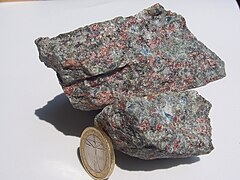Omphacite
| Omphacite | |
|---|---|

|
|
| General | |
| Category | Pyroxene |
|
Formula (repeating unit) |
(Ca,Na)(Mg,Fe2+,Al)Si2O6 |
| Strunz classification | 9.DA.20 |
| Dana classification | 65.01.03b.01 (clinopyroxene) |
| Crystal system | Monoclinic |
| Crystal class | Prismatic (2/m) (same H-M symbol) |
| Space group | P2/n or C2/c |
| Unit cell | a = 9.66, b = 8.81, c = 5.22 [Å]; β = 106.56°; Z = 4 |
| Identification | |
| Color | Green to dark green; colorless to pale green in thin section |
| Crystal habit | Rarely in rough crystals; anhedral, granular to massive |
| Twinning | Single and polysynthetic twinning common on {100} |
| Cleavage | Good on {110}, {110} ^ {110} ≈87°; parting on {100} |
| Fracture | Uneven to conchoidal |
| Tenacity | Brittle |
| Mohs scale hardness | 5-6 |
| Luster | Vitreous to silky |
| Streak | Greenish white |
| Diaphaneity | Translucent |
| Specific gravity | 3.16-3.43 |
| Optical properties | Biaxial (+) |
| Refractive index | nα = 1.662 - 1.701 nβ = 1.670 - 1.712 nγ = 1.685 - 1.723 |
| Birefringence | δ = 0.023 |
| Pleochroism | Weak; X = colorless; Y = very pale green; Z = very pale green, blue-green |
| 2V angle | Measured: 58° to 83°, Calculated: 74° to 88° |
| References | |
Omphacite is a member of the pyroxene group of silicate minerals with formula: (Ca, Na)(Mg, Fe2+, Al)Si2O6. It is a variably deep to pale green or nearly colorless variety of pyroxene. Omphacite compositions are intermediate between calcium-rich augite and sodium-rich jadeite. It crystallizes in the monoclinic system with prismatic, typically twinned forms, though usually anhedral. Its space group (P2/n) is distinct from that of augite and jadeite (C2/c). It exhibits the typical near 90° pyroxene cleavage. It is brittle with specific gravity of 3.29 to 3.39 and a Mohs hardness of 5 to 6.
It is a major mineral component of eclogite along with pyrope garnet and also occurs in blueschist facies and UHP (ultrahigh-pressure) metamorphic rocks. It also occurs in eclogite xenoliths from kimberlite as well as in crustal rocks metamorphosed at high pressures. Associated minerals in eclogites include garnet, quartz or coesite, rutile, kyanite, phengite, and lawsonite. Minerals such as glaucophane, lawsonite, titanite, and epidote occur with omphacite in blueschist facies metamorphic rocks. The name "jade," usually referring to rocks made of jadeite, is sometimes also applied to rocks consisting entirely of omphacite.
...
Wikipedia
